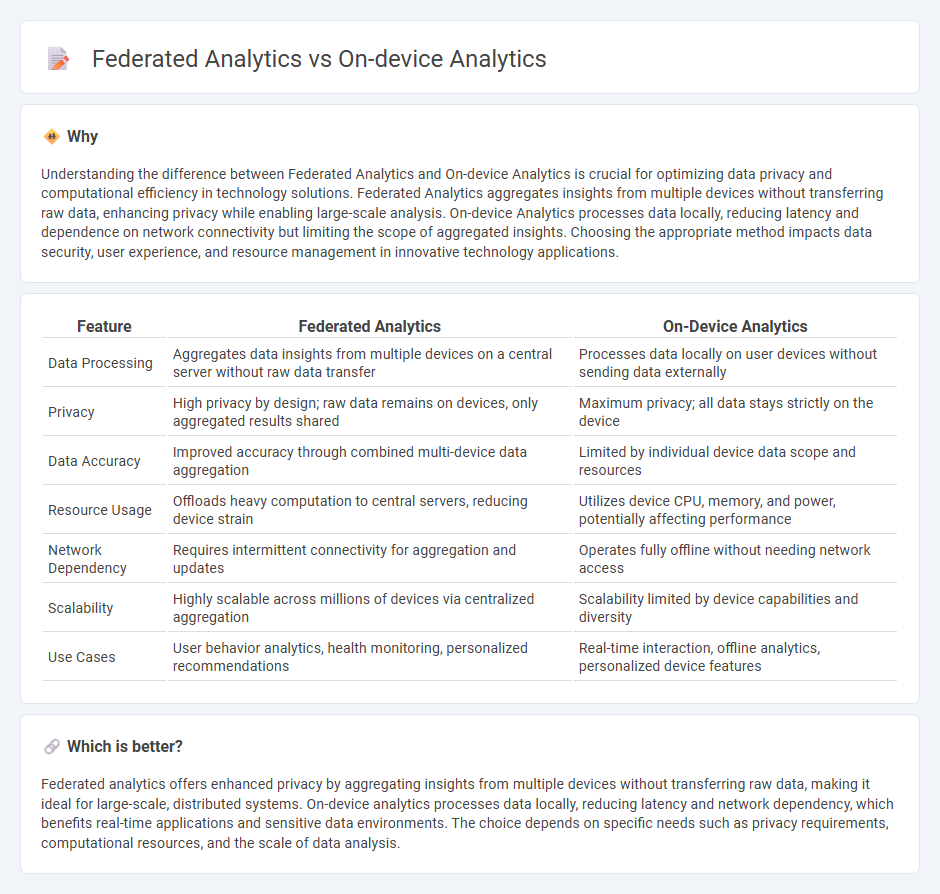
Federated analytics enables data analysis across multiple devices or servers without centralizing raw data, enhancing privacy by processing information locally and sharing only aggregated insights. On-device analytics performs data processing directly on individual devices, minimizing data transmission and enabling real-time personalized insights while maintaining user confidentiality. Explore the advantages and use cases of federated analytics and on-device analytics to understand their impact on data privacy and efficiency.
Why it is important
Understanding the difference between Federated Analytics and On-device Analytics is crucial for optimizing data privacy and computational efficiency in technology solutions. Federated Analytics aggregates insights from multiple devices without transferring raw data, enhancing privacy while enabling large-scale analysis. On-device Analytics processes data locally, reducing latency and dependence on network connectivity but limiting the scope of aggregated insights. Choosing the appropriate method impacts data security, user experience, and resource management in innovative technology applications.
Comparison Table
| Feature | Federated Analytics | On-Device Analytics |
|---|---|---|
| Data Processing | Aggregates data insights from multiple devices on a central server without raw data transfer | Processes data locally on user devices without sending data externally |
| Privacy | High privacy by design; raw data remains on devices, only aggregated results shared | Maximum privacy; all data stays strictly on the device |
| Data Accuracy | Improved accuracy through combined multi-device data aggregation | Limited by individual device data scope and resources |
| Resource Usage | Offloads heavy computation to central servers, reducing device strain | Utilizes device CPU, memory, and power, potentially affecting performance |
| Network Dependency | Requires intermittent connectivity for aggregation and updates | Operates fully offline without needing network access |
| Scalability | Highly scalable across millions of devices via centralized aggregation | Scalability limited by device capabilities and diversity |
| Use Cases | User behavior analytics, health monitoring, personalized recommendations | Real-time interaction, offline analytics, personalized device features |
Which is better?
Federated analytics offers enhanced privacy by aggregating insights from multiple devices without transferring raw data, making it ideal for large-scale, distributed systems. On-device analytics processes data locally, reducing latency and network dependency, which benefits real-time applications and sensitive data environments. The choice depends on specific needs such as privacy requirements, computational resources, and the scale of data analysis.
Connection
Federated analytics and on-device analytics both process data locally on user devices to enhance privacy and reduce data transmission to central servers. Federated analytics aggregates insights from multiple devices without sharing raw data, while on-device analytics performs real-time data analysis directly on the device. This connection enables efficient, privacy-preserving analytics by combining decentralized data processing with collective intelligence.
Key Terms
Data Privacy
On-device analytics processes data locally on user devices, minimizing data exposure and enhancing privacy by limiting the need to transmit personal information to central servers. Federated analytics aggregates insights from multiple devices without transferring raw data, ensuring sensitive information remains decentralized and protected. Explore the detailed differences and benefits of these privacy-focused analytics methods to make informed decisions.
Edge Computing
On-device analytics processes data locally on smartphones, IoT gadgets, and edge devices, reducing latency and minimizing data transmission to central servers, thus enhancing privacy and response times. Federated analytics aggregates insights from decentralized devices without sharing raw data, enabling collaborative machine learning while maintaining data sovereignty across edge environments. Explore the distinct advantages and use cases of on-device and federated analytics in edge computing to optimize data processing strategies.
Model Aggregation
Model aggregation in on-device analytics involves combining locally processed data summaries on the device before sharing, limiting raw data exposure and improving privacy. Federated analytics aggregates model updates from multiple devices on a central server, enabling comprehensive insights without transferring raw data. Explore the differences in model aggregation techniques to enhance data privacy and analytics efficiency.
Source and External Links
On-Device Analytics and Observability: New Frontiers in the Data Landscape - On-device analytics processes data locally where it is generated, offering advantages such as reduced latency, enhanced privacy, and improved efficiency, enabling real-time decision-making especially in critical applications without cloud dependency.
Device Analytics | ThinScale | Secure & Manage Endpoints at Scale - Device analytics provides IT teams with real-time monitoring and insights into device health and performance metrics like CPU usage, memory, bandwidth, network quality, storage, and event logs for optimized management and troubleshooting across device estates.
Device Analytics for Fieldwork Productivity | Samsung Knox Blog - Mobile device analytics enhance enterprise productivity by delivering detailed information on device performance, behavior, and app health, helping organizations detect issues early, optimize device fleets, and achieve unified endpoint management goals with improved security and automation.
 dowidth.com
dowidth.com